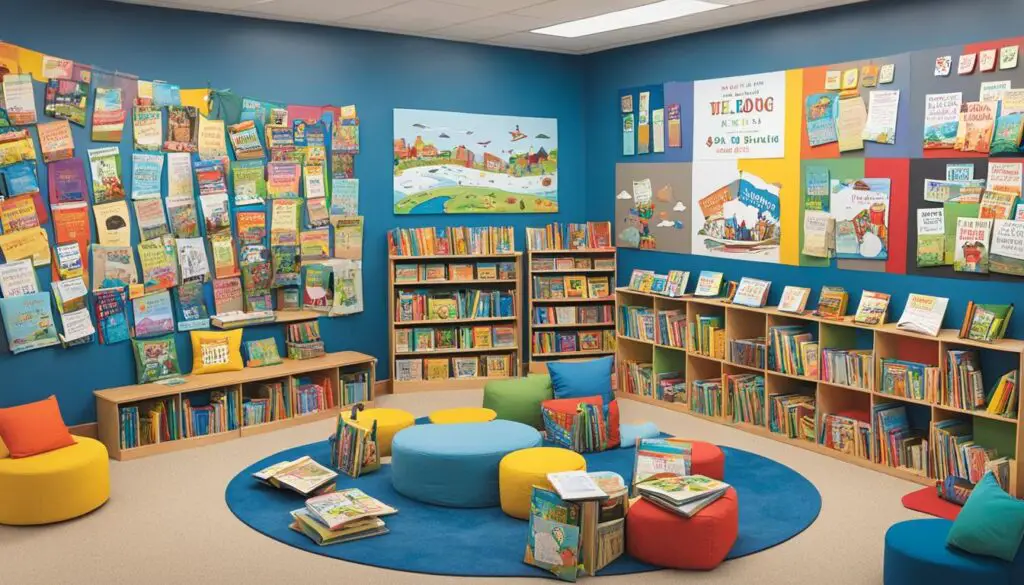
Strategies to Enhance Children’s Reading Skills
As a professional copywriting journalist, I have observed that developing strong reading skills is essential for children’s academic and personal success. Research suggests that children who read proficiently are likely to perform better in school, have higher levels of confidence, and experience enhanced emotional well-being. Therefore, it is crucial to implement effective strategies for developing children’s reading skills.
Strategies for developing children’s reading skills aim to foster a love of reading and enhance overall literacy. These strategies encourage children to cultivate strong reading habits and engage in various reading activities.
Key Takeaways:
- Developing strong reading skills is essential for children’s academic and personal success.
- Effective strategies for developing reading skills aim to foster a love of reading and enhance overall literacy.
- Encouraging children to cultivate strong reading habits can lead to improved learning outcomes and emotional well-being.
- Implementing effective strategies requires a combination of read-aloud sessions, creating a print-rich environment, and encouraging independent reading.
- Cultivating strong reading skills from an early age sets the foundation for lifelong learning and success.
Importance of Read-Aloud Sessions
When it comes to developing children’s reading skills, read-aloud sessions should not be overlooked. These sessions provide an opportunity for children to engage with various texts and improve their vocabulary, comprehension, and fluency. In addition, read-aloud sessions can enhance children’s listening skills and promote a love of reading (note: “love of reading” is one of the SEO keywords for this section).
Research has shown that read-aloud sessions can have a significant impact on children’s literacy development. According to the National Institute of Child Health and Human Development, reading aloud to young children can stimulate brain development and help build key language, literacy, and social-emotional skills.
While it may seem like a simple activity, there are a few tips to keep in mind when conducting read-aloud sessions. First, choose age-appropriate texts that capture children’s interest and align with their reading level. Second, encourage children to participate by asking questions about the story or characters. Finally, make read-aloud sessions a regular part of your routine to establish a consistent reading habit.
The Benefits of Read-Aloud Sessions
Read-aloud sessions offer various benefits that can help children’s literacy development in the long term. Some of the most notable benefits include:
| Benefit | Description |
|---|---|
| Improved Vocabulary | By exposing children to a variety of texts, read-aloud sessions can help improve their vocabulary and understanding of language. |
| Enhanced Comprehension Skills | Through discussions about the story or characters, children can develop stronger comprehension skills and better understand the content. |
| Increased Fluency | Regular exposure to read-aloud sessions can help children develop their reading fluency, making it easier for them to read on their own. |
Overall, read-aloud sessions are a valuable tool for parents and educators looking to enhance children’s reading skills and promote literacy development.
Creating a Print-Rich Environment
As mentioned earlier, a print-rich environment is vital for enhancing children’s reading skills. Surrounding children with books, labels, and other reading materials, allows for consistent exposure to text, which can boost literacy. Not only does a print-rich environment promote reading, but it also inspires children’s love for books and learning.
Here are some useful tips for creating an engaging print-rich environment:
- Fill bookshelves with diverse books
- Add labels to items around the house, such as furniture or appliances
- Display children’s artwork with written descriptions
- Hang up posters with educational content or quotes about reading
- Create a cozy reading nook with comfortable seating and soft lighting
- Encourage children to create their own books or stories and display them in a prominent location
Remember that the books and materials should be age-appropriate and interesting to the child. A colorful and visually appealing environment can capture the child’s attention and encourage them to explore on their own.

The Benefits of a Print-Rich Environment
A print-rich environment can impact children’s literacy positively. According to a study conducted by the National Center for Education (NCES), third-grade students who have access to a wide range of books scored higher on reading tests. The environment provides a conducive setting for children to explore, learn, and develop reading skills.
| Benefits of a print-rich environment | How it helps children’s literacy |
|---|---|
| Exposure to a variety of texts and genres | Improves vocabulary and comprehension |
| Opportunities to practice reading | Develops fluency and speed |
| Increases interest in reading | Motivates children to read and learn |
| Encourages critical thinking and curiosity | Promotes exploration and discovery |
Overall, creating a print-rich environment is an excellent way to promote children’s literacy. Incorporating books and other reading materials into a child’s daily routine can help them develop a love for reading and build essential skills that will benefit them throughout their lives.
Encouraging Independent Reading
Independent reading is an essential skill that aids children in developing their reading ability. Encouraging children to read on their own and providing them with appropriate materials can help them develop a love for reading. Here are some techniques that can promote independent reading habits:
- Select appropriate books: Find books that are age-appropriate and match your child’s interests. This will encourage them to read and want to read more.
- Set reading goals: Help children set achievable reading goals and track their progress. Celebrate their accomplishments to keep them motivated.
- Establish reading time: Set aside dedicated reading time each day. This will create a reading routine for children and develop a habit.
By implementing these techniques, parents, educators, and caregivers can promote a love of reading and cultivate independent reading habits in children. Independent reading not only enhances reading skills but also improves vocabulary, comprehension, and critical thinking. So, make sure to encourage independent reading and make it a regular part of a child’s routine.

Conclusion
In conclusion, as a professional copywriting journalist, it is essential to recognize and emphasize the importance of developing children’s reading skills. By implementing effective strategies, parents, educators, and caregivers can help children cultivate a love of reading and build strong literacy skills that will benefit them throughout their lives.
Read-aloud sessions, creating a print-rich environment, and encouraging independent reading are all vital components that contribute to enhancing children’s reading skills. It is crucial to provide children with ample opportunities to engage in various reading activities and to make reading a fun and enjoyable experience.
Developing strong reading skills from an early age sets the foundation for academic success and lifelong learning. As a copywriting journalist, I recognize the impact of promoting literacy and will continue to advocate for the importance of reading and developing good reading habits.
FAQ
What are some effective strategies for developing children’s reading skills?
There are several strategies that can be employed to enhance children’s reading skills. Some of the most effective strategies include read-aloud sessions, creating a print-rich environment, and encouraging independent reading.
Why are read-aloud sessions important for children’s reading skills?
Read-aloud sessions play a crucial role in developing children’s reading skills. They help improve vocabulary, comprehension, and fluency. By listening to stories, children also develop a love for reading and storytelling.
How can a print-rich environment enhance children’s literacy?
Surrounding children with books, labels, and other reading materials creates a print-rich environment that fosters their literacy skills. It exposes them to a variety of texts, encourages exploration, and cultivates a curiosity for reading and learning.
What are some techniques to encourage independent reading in children?
There are several techniques to promote independent reading habits in children. This includes selecting age-appropriate books that match their interests, setting reading goals, establishing dedicated reading time, and providing a comfortable reading space.
How can implementing these strategies benefit children’s overall development?
By implementing these strategies, parents, educators, and caregivers can help children enhance their reading skills. Cultivating strong reading skills from an early age sets the foundation for lifelong learning, improves cognitive abilities, fosters creativity, and expands their knowledge and understanding of the world.